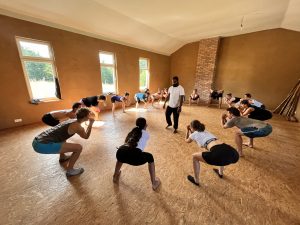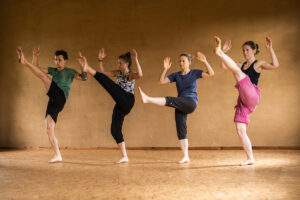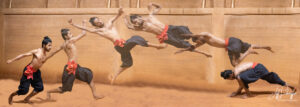Although the awareness of the existence of kalarippayattu (in short kalari), as well as the basic knowledge about this discipline, are still developing, there are at least a few books on kalari, and gradually new ones are published (in November 2021 the first book on kalari in Polish, written by myself, will be published).
Who writes books on kalari?
Some of the books are written by researchers, travelers, theoreticians and/or practitioners of martial arts from outside of India who are fascinated by this art, and their purpose is primarily to introduce it to wider audience by showing the historical and cultural background, philosophy, holistic approach to practice and connection with the medical system, as well as by viewing kalarippayattu as a path of personal development.
The authors of other books – mainly in the Malayalam language spoken in Kerala – are usually masters who want to popularize kalari among the Keralan society, as well as to provide knowledge about specific sequences and techniques. Some of these books have been translated into English.
What’s in the books?
 Regardless of the author’s nationality, the information included in some books is based on the style and tradition of a particular school (because it was written by a master or someone related to that school in a certain way), while others treat the subject more generally or comparatively and discuss different schools , styles and techniques.
Regardless of the author’s nationality, the information included in some books is based on the style and tradition of a particular school (because it was written by a master or someone related to that school in a certain way), while others treat the subject more generally or comparatively and discuss different schools , styles and techniques.
All books include, in different range, information on history, mythology, elements of training and combat techniques, customs related to practice, and also discuss the connection between the martial art and the traditional medical system (kalari chikitsa) and massage, as well as the performative arts of Kerala (including kathakali theatre).
Can you learn kalari from a book?
Of course it is a provocative question. Some books are fully or mostly theoretical, while others try to convey knowledge of the techniques of this martial art and enable its practical application. However, technical tips and instructions may be helpful rather for people who have already had some experience in kalari practice. For readers for whom this art is completely unknown and whose purpose is not to recreate specific patterns, this type of information may be too detailed and incomprehensible. Such people will benefit more from publications that include photos but discuss the practice in a more general way.

A perfect situation would be to get inspired by a book enough to just take part in a training – in the times of online communication, kalari is not that unavailable anymore. Although it seemed impossible to teach a martial art online, it turned out that actually kalari offers a lot of possibilities for individual practice.
In this article I was discussing the issue of kalari online versus offline, and here you will find out what you can learn online (and subscribe to our online trainings).
List of books
In this article, I will focus on books on kalari published in English and French (including two translations from Malayalam), and I will discuss books available in Malayalam in a separate article (after a consultation with a native speaker). I bought most of them in bookstores in Trivandrum, but many are also available for purchase online, mainly at Amazon (some are in electronic version).
When the Body Becomes All Eyes. Paradigms, Discourses and Practices of Power in Kalarippayattu, a South Indian martial art, Phillip B. Zarrilli
 This book is an essential reading for kalarippayattu enthusiasts. First published in 1998 and reprinted many times, it is the first comprehensive publication on kalari in the West. Its author is an American director, teacher and theatre researcher Phillip B. Zarrilli, who passed away in 2020, who incorporated kalarippayattu, yoga and tai chi into his theatre work and in the teaching work with students of drama at the University of Exeter (Great Britain), where he worked many years. He also built there his own kalari, where the classes were held.
This book is an essential reading for kalarippayattu enthusiasts. First published in 1998 and reprinted many times, it is the first comprehensive publication on kalari in the West. Its author is an American director, teacher and theatre researcher Phillip B. Zarrilli, who passed away in 2020, who incorporated kalarippayattu, yoga and tai chi into his theatre work and in the teaching work with students of drama at the University of Exeter (Great Britain), where he worked many years. He also built there his own kalari, where the classes were held.
Zarrilli first encountered kalarippayattu in 1976 while traveling to Kerala where he studied classical theatre kathakali (he is also an author of a book on this subject). His fascination with the martial art turned into a great passion that brought him to India many times in the following years.
The book is based on over 20 years of personal practice and field research that Zarrilli conducted during regular, many-month stays in Kerala between 1976-1993. Although he spent most of his time at CVN Kalari Sangham in Trivandrum, where he practiced under the guidance of master Govindankutty Nair and from whom he obtained permission (as the first person from outside of India) to teach, he also traveled extensively around Kerala, observed other schools and interviewed other masters and kalari adepts, thanks to which the book shows, among others, the similarities and differences between different kalari styles and schools.
In the following chapters, the author discusses issues such as the history and the present day of Kerala, the construction and rituals of the kalari (training building), physical training, the subtle aspects of energy practice, the kalari chikitsa medical system, and the relationship between with kathakali theatre practice. He also lists texts that exist in the kalari tradition and lists the masters and schools he visited during his fieldwork.
The work contains a lot of information in the field of ethnography, anthropology and cultural studies, showing the role and functioning of this art in the Kerala society, which allows a better understanding of its unique character. A great contribution to it are numerous interviews and quotations from Kalari masters and students, showing their personal perspective and attitude to practice.
This is not a book for people who want just specific training instructions and tips.
The book contains many illustrations, charts and tables that complete the information contained in the text.
The Martial Arts Tradition of India, Patrick Denaud
 The book was originally published in French in 1996 and in English in 2009 by a French reporter and documentary filmmaker, Patrick Denaud.
The book was originally published in French in 1996 and in English in 2009 by a French reporter and documentary filmmaker, Patrick Denaud.
This book also covers, although in a much more general, fragmentary and superficial manner, topics such as history, the practice of kalarippayattu and its psychological aspect, its relationship to traditional medicine and theatre, and the influence of kalari on Chinese martial arts.
Despite interesting reflections and looking at some issues, much of the information contained in the book seems to be based on quick observations made in few schools, because the theses made on their basis do not show a wider spectrum of this art and its functioning in Kerala.
 The book contains an interview with two masters: P. S. Balachandran (Indian School of Martial Arts), to whom the author dedicates the book, and Sathyanarayanan Govindankutty Nair (C.V.N. Kalari Sangham) – the son of Govindankutty Nair, who was the master of Phillip Zarrilli.
The book contains an interview with two masters: P. S. Balachandran (Indian School of Martial Arts), to whom the author dedicates the book, and Sathyanarayanan Govindankutty Nair (C.V.N. Kalari Sangham) – the son of Govindankutty Nair, who was the master of Phillip Zarrilli.
Le kalaripayat. L’Ancêtre de tous les arts martiaux d’Asie, Tiego Bindra
 A book in French by Tiego Bindra, a martial arts specialist, was published in 2005.
A book in French by Tiego Bindra, a martial arts specialist, was published in 2005.
It is a very short and general introduction to kalarippayattu. The author discusses the basic elements of the practice, presents the figures of the two masters (Pramod Gurukkal and Prasad) and their statements, as well as the relationship of kalari with the Buddhist tradition and traditional Indian medicine. The last part of the book briefly discusses Chinese and Japanese martial arts, which the author draws from the Buddhist tradition that has its roots in southern India.
Kalarippayat. The Structure and Essence of an Indian Martial Art, Dick H. Luijendijk

A book (published in 2008, electronic version in 2011) contains a lot of detailed and practical information about kalarippayattu.
Kalarippayat: India’s Ancient Martial Art, Dick H. Luijendijk
 Unlike the book by the same author discussed above, this one, published in 2005, focuses on practical instructions for selected sequences in the Northern, Central and Southern styles which the author was learnining for 10 years from Gurukkal Sherif.
Unlike the book by the same author discussed above, this one, published in 2005, focuses on practical instructions for selected sequences in the Northern, Central and Southern styles which the author was learnining for 10 years from Gurukkal Sherif.
 Big and clear photos have precise captions which explain the movemements and their meanings. There are postures and movements described, as well as some techniques with weapons. The book includes also basic information on the medical system, kalari chikitsa, and massage.
Big and clear photos have precise captions which explain the movemements and their meanings. There are postures and movements described, as well as some techniques with weapons. The book includes also basic information on the medical system, kalari chikitsa, and massage.
Kalarippayattu. The Complete Guide to Kerala’s Ancient Martial Art, Chirakkal T. Sreedharan Nair
 A book originally published in Malayalam in 1963, printed in English in 2007. Its author is the legendary master Chirakkal T. Sreedharan Nair, who founded Sree Bharat Kalari school in 1948 and promoted kalarippayattu as a practitioner, researcher and theorist.
A book originally published in Malayalam in 1963, printed in English in 2007. Its author is the legendary master Chirakkal T. Sreedharan Nair, who founded Sree Bharat Kalari school in 1948 and promoted kalarippayattu as a practitioner, researcher and theorist.
After a short initial historical and theoretical part, the main part of the book follows which contains numerous descriptions of exercises, sequences and sequences of empty hand combat, as well as combat with weapons taught at his school, illustrated with photographs, as well as accompanying commands (in English translation)
For experienced practitioners of the Northern Kalari style, this book may be a kind of syllabus of techniques and sequences (although the Malayalam version of the book will probably be more useful for them), but for beginners (and / or theorists) it will be only illustrative material, giving a very general idea about certain positions, movements and types of weapons.
Kalarippayattu. History and Methods of Practising the Martial Art of Kerala, P. Balakrishnan
 It is also a book that was originally published in 1995 in Malayalam, and its English translation was published in 2003. Its author, P. Balakrishnan, practiced kalarippayattu from an early age. He became a co-founder and member of the Kerala Kalarippayattu Association.
It is also a book that was originally published in 1995 in Malayalam, and its English translation was published in 2003. Its author, P. Balakrishnan, practiced kalarippayattu from an early age. He became a co-founder and member of the Kerala Kalarippayattu Association.
The book provides background information on Kerala’s history and warrior traditions, types of weapons, local differences between styles and schools, and links to the medical system. The main part is dedicated to practice – positions, steps, sequences and arrangements of fights with weapons and empty hand combat (in the Northern style, in the tradition of the C.V.N. Kalari school). Most of the basic elements (exercises, positions and steps) are preceded by interesting and detailed descriptions containing technical information on how to perform them, and they are completed by large photos. The next, more complex and complicated sequences are not shown in the photos, but only described.
Although the book contains a lot of technical information, it is provided in an comprehensible way even for people who will not use sequences of commands and combat patterns in practice.
Kalarippayattu: Guide Book, Jules Morel and Maneesh Mohanan

An e-book published in January 2021 by Jules Morel and Maneesh Mohanan who represent the Kalari Kshetra School located in Auroville and Pondicherry. The school continues the tradition of the master of the northern style, E. P. Vasudevan Gurukkal.
The publication provides brief and general information on the history of kalarippayattu and the division into styles, while the main part of the book contains illustrations and descriptions of training elements such as positions of animals, types of kicks, movement sequences (Malayalam commands are provided in English transliteration), as well as information about different types of weapons.
 The content of the book is essentially the content of a free app created by Jules Morel. The authors emphasize that the publication is intended to help beginner students who practice under the supervision of a master, to systematize their knowledge.
The content of the book is essentially the content of a free app created by Jules Morel. The authors emphasize that the publication is intended to help beginner students who practice under the supervision of a master, to systematize their knowledge.
Books that I know but haven’t had the chance to read yet:
Kalari Margam. Ancient Secrets for Modern Living, Ranjan Mullarat
The album contains photographs showing the practice of kalari in the school led by master Ranjan Mullarat in Bangalore. The photos show various elements of the practice (preparation for training, exercises, weapons, healing techniques) and are accompanied by short descriptions.
The article will be gradually updated along with further reading.
I’m curious if you knew any of these books and if the article was useful for you. If you feel like sharing your opinion, please leave a comment below. And of course if you know any other books, please let me know! 🙂
 In autumn 2022, the first Polish book on kalarippayattu: Kalarippayattu. A Holistic Martial Art from India written by myself was published and it will be available as an e-book by the end of January 2023.
In autumn 2022, the first Polish book on kalarippayattu: Kalarippayattu. A Holistic Martial Art from India written by myself was published and it will be available as an e-book by the end of January 2023.





 Kalarippayattu and Performing Arts
Kalarippayattu and Performing Arts 8 best documentaries on kalari
8 best documentaries on kalari
 Kalari practice in India
Kalari practice in India

 Regularity in kalari practice
Regularity in kalari practice Kalari, kalaripayat or kalarippayattu?
Kalari, kalaripayat or kalarippayattu? Animal postures
Animal postures 10 typical kalari exercises
10 typical kalari exercises Uniting kalari through photos – an interview with an American photographer Jeff Schaeffer
Uniting kalari through photos – an interview with an American photographer Jeff Schaeffer Books on kalarippayattu
Books on kalarippayattu 10 years of Studio Kalari
10 years of Studio Kalari